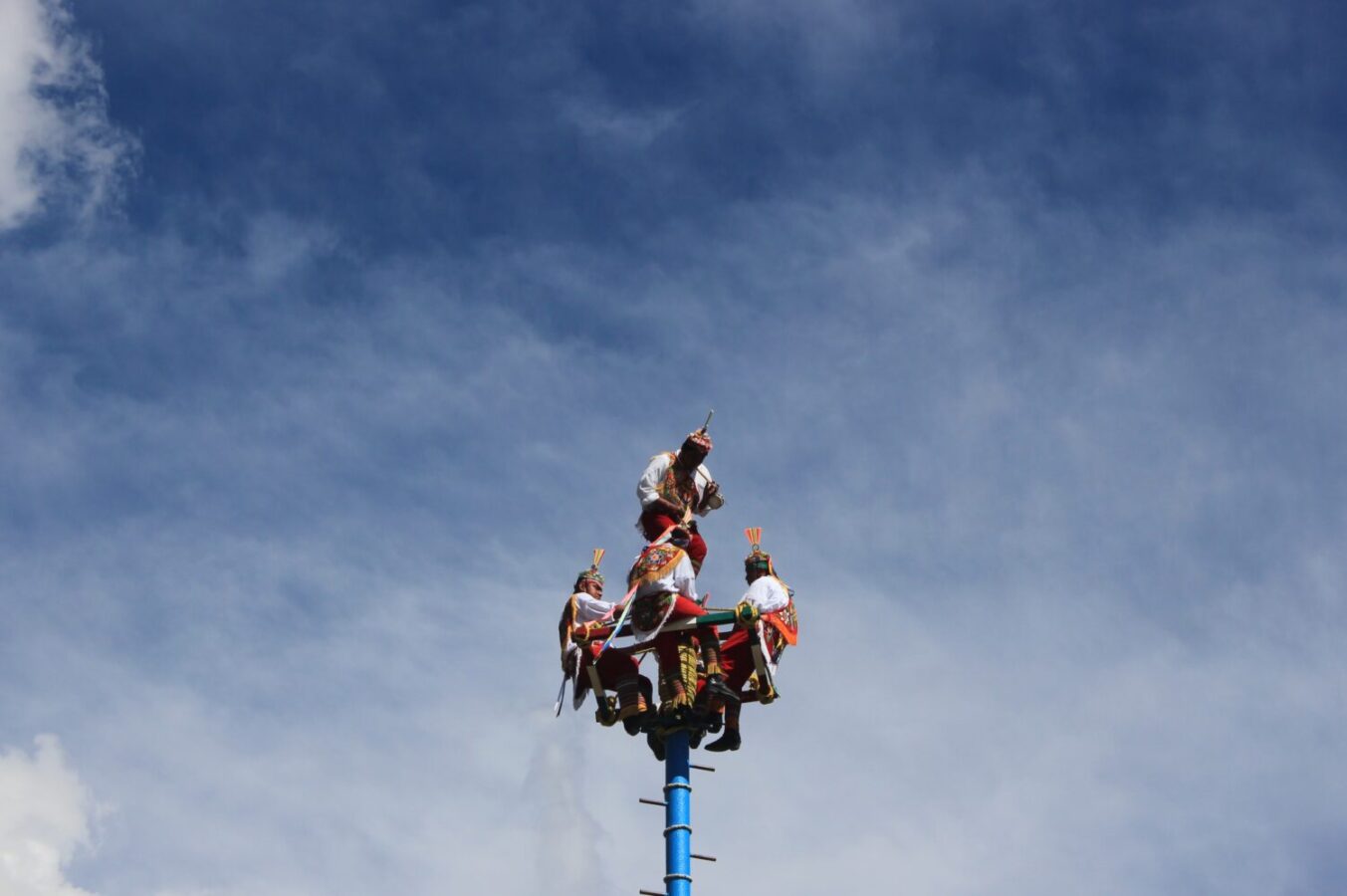Within the immense mysticism surrounding Mexican traditions, our dances are amongst the most admired demonstrations due to the mystery of their origins and the beauty of the colorful traditional garments worn.
Of all the dances of the Prehispanic Peoples, there is a particular one that requires a special amount of grit. “The Flyers’ Dance”, a ceremonial ritual of the Totonaca People for fertility and abundance.
The ceremony accompanying the flight of The Papantla Flyers has endured through generations, taking part in the cultural heritage of humanity worldwide since 2009.
Follow me on this downward spiral through history as we uncover the legends of this breathtaking dance:
THE RISE OF THE FLYERS
Legend has it that many years ago, a severe drought in the Totonacapan area (which includes the limits of the current states of Veracruz and Puebla) caused big devastation among the towns that lost a large part of their inhabitants, therefore a group of wise old men entrusted some chaste young men to locate and cut down the tallest, strongest, and straightest tree on the mountain, to use it in a ceremony to ask The Gods for their benevolence to grant them rain and restore its fertility to the land. These prayers had to be loud and carried out at the top of the trunk so that they could be heard at the heights by its protectors.
After the great results that this ceremony yielded, it became a tribute to be carried out periodically, usually at the beginning of spring, hoping for good fertility in their crops.
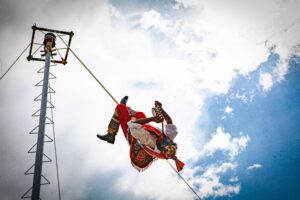
Photo by Alfonso Betancourt
THE FLIGHT OF THE BIRD-MEN
Traditionally, The Papantla Flyers are made up of a group of five people from the indigenous group of the Totonaca region. Their training takes place in the city of Papantla, at a school located in the Takilhsukut Park in Veracruz. Of the 5 people, one holds the position of Caporal or chief, who is the highest authority of the group, symbolizing the center of the earth, and is in charge of playing the drum and the flute, the other remaining four are the Flyers who represent the four cardinal points.
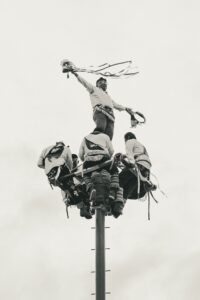
Photo by Andrea Román
Back in the day, the ritual began with the selection of the “flying pole” by the Caporal, who would go into the forest in search of the perfect tree. Once it was located, a ceremony was performed to ask forgiveness from the forest for taking the life of one of its living beings, and offerings were placed while all the Flyers danced around the tree pointing out the four cardinal points with puffs of hard liquor.
To the rhythm of dances and music, the trunk was transferred from the mountains to the heart of the town and no other person or thing could touch it, not even the ground until it was settled in a hole in the ground filled with more offerings, and a later a rope ladder was weaved around it to allow the flyers to reach the top.
Together, the flyers dance orderly around the “flying pole” with their heads bowed as a sign of humility and respect for The Gods, while the Caporal is playing the “Flyers Son” with his drum and flute. Upon reaching the foot of the “flying pole,” the Bird-Men make a series of turns around it, and one by one, the four Flyers climb the trunk until they reach a frame, called Tecomate, where they sit at each end to balance the weight. The last to climb is the Caporal, who upon reaching the top, stands on the Tecomate, and performs a series of jumps accompanied by an impressive tap dance with which he seems to want to nail the pole a little more.
The Caporal, rotating on his axis, points to the four cardinal points, starting from the east and counterclockwise. At the end of his part of the ritual, the Caporal remains seated on the Tecomate and, it is worth mentioning, that he does all this while playing two musical instruments the whole time.
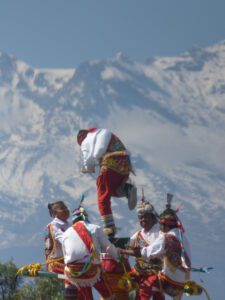
Source: Wikipedia Commons
Finally, the Flyers, who are tied with a rope from their waist to the Tecomate, upon hearing a certain melody and in perfect coordination, jump into the void face down, spreading their arms like the wings of a bird in mid-flight, an acrobatics that symbolizes the fall of rain and where his multicolored plumes stand out.
The Flyers rotate 13 times, each of them simulating descending through the 13 skies of the God Sun, which multiplied by the four flyers gives the result of 52, this number is the symbol of the 52-year cycle of the indigenous calendar. When approaching the ground they flip to be able to get back on their feet, holding their ropes to balance the trunk and facilitating the descent of the Caporal.
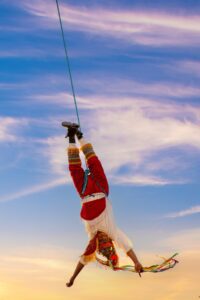
Photo by Fabiola Vica
In the present day, the first part of the ritual is only performed on very special occasions but with some modifications, as for the final part of the ceremony, we can witness it in many different certified spots all over México.
THE FLYING POLE
Before fixing the trunk at the site of the ceremony, a ritual was carried out consisting of the “planting” or placing of animals, tobacco, and tamales which were covered with liquor, this served as an offering so that the pole would not claim the lives of the dancers.
The “flying pole” is composed of the trunk, which is embedded in the ground, at the upper end of which it supports the Tecomate, a rotating apparatus, and the main point of support and balance for the dancers.
Currently, the use of steel posts with small metal steps has become more useful, with only the frame and Tecomate being kept made of wood. At Papantla, the post is 121 feet tall, while the one at Mexico City is only 82 feet.
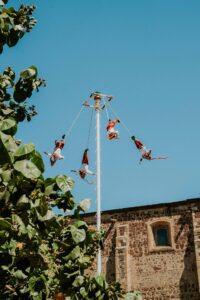
Photo by Amar Preciado
ESSENTIAL ELEMENTS OF THE RITUAL
TRADITIONAL GARMENTS
The original clothing of the Papantla Flyers were costumes made with authentic bird feathers that represented eagles, owls, crows, macaws, quetzals, and mockingbirds. Currently, the Totonac indigenous people wear the Flyer’s Suit over their traditional white blanket garment.
Traditionally, the young flyer covers his head with a bandana and on top of it a hat with a small colorful plume resembling the crest of a bird, through a round mirror, the sun rays are projected. Long ribbons attached to the back of the hat symbolize the rainbow that is generated after the rain. The rest of the headdress is decorated with colorful flowers as a symbol of the fertility of Mother Earth. All the dancers complete their outfits with red calf-length pants with bead decorations, worn with leather ankle boots. The fact that the clothing is red symbolizes the blood of the fallen flyers and the heat of the sun. On their backs they carry two half circles, covered in red velvet, these allude to the wings of birds. Above these semicircles appear figures of flowers, plants, and birds of multiple colors, which refer to the beauty of spring.
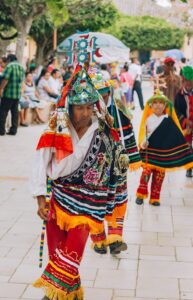
Photo by Alex Wolf
WITHOUT MUSIC THERE IS NO DANCE
The Son of the Flyers is a name used to name the musical repertoire used in the Papantla Flyers ceremony. The Caporal also builds the drum and the flute with materials obtained mostly from the natural environment of the region. The drum is made of wood with two leather covers, it is attached to the palm of the caporal’s hand utilizing a bracelet-like tie and is hit with a small drumstick marking the rhythm. On the other hand, the three-hole flute complements the notes of the ritual. The simplicity of the instruments demonstrates great creativity and the knowledge of harmony and acoustics that the Totonaca people possess.

Source: Wikipedia Commons
Although the Riviera Maya is a little far from Papantla, the Flyers come all the way here to marvel locals and tourists with their typical costumes, traditional dances, and music. Almost every day at Parque Fundadores in Playa del Carmen visitors can witness the performance of the Papantla Flyers, but if you are planning on visiting Xcaret you will also get a nice view of this amazing ceremony.
Until next time we fly together.
-Abbey.

